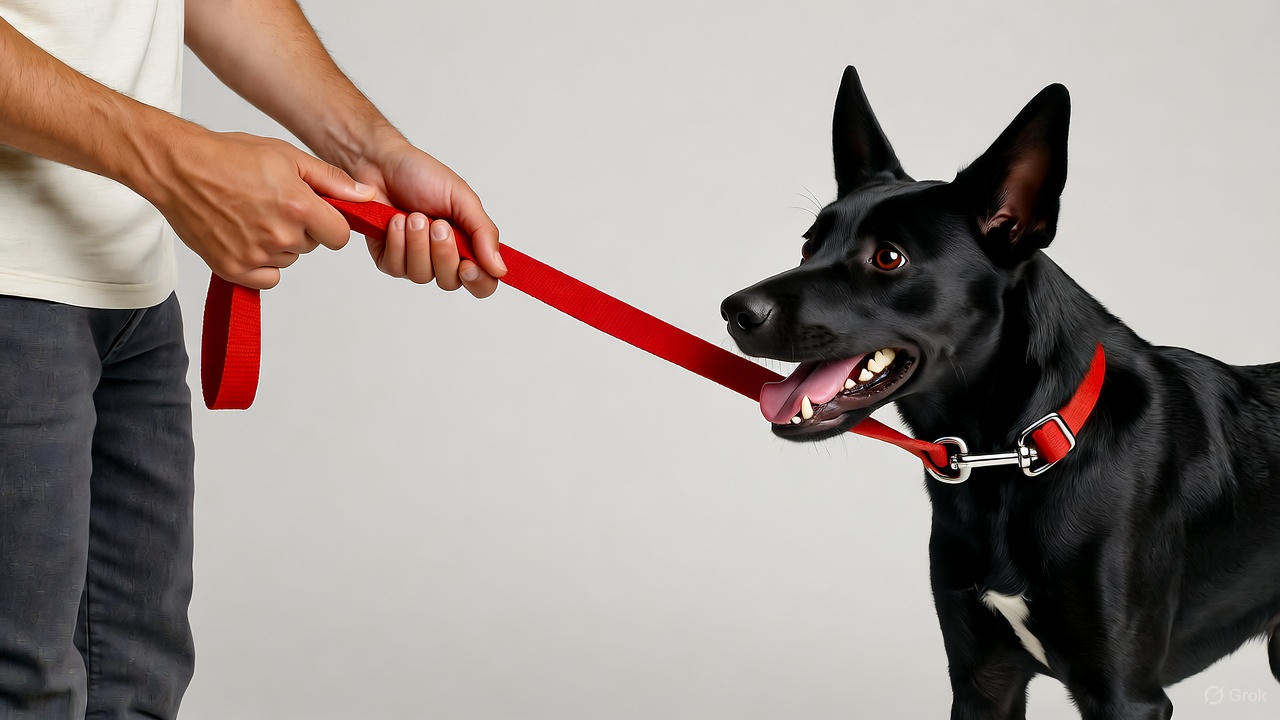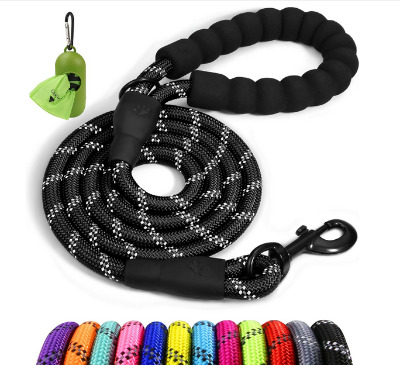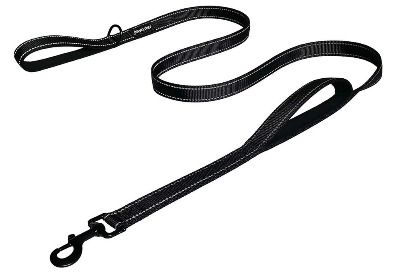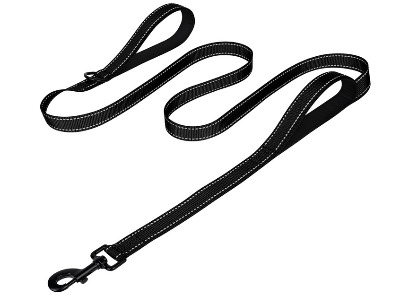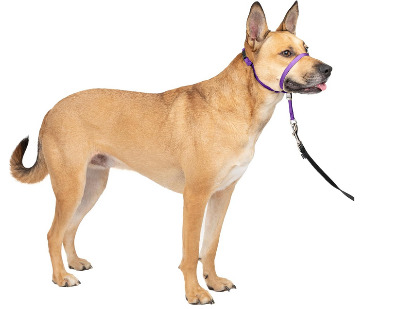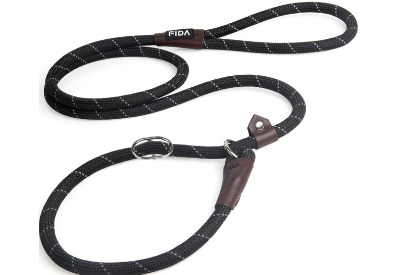5 Best Leash for a Pulling Dog In 2025
Walking your dog should be an enjoyable experience, but when your furry friend constantly pulls, it can quickly turn into a frustrating struggle. A strong, determined dog can transform a peaceful stroll into a battle of wills, leaving you with sore arms and an unpleasant outing. The right leash makes all the difference in managing a dog that pulls, giving you better control while keeping your pet safe and comfortable.
Many dog owners struggle with pulling behavior, especially those with medium to large breeds. Your dog’s excitement, curiosity, or strong prey drive can lead to constant tugging that makes walks exhausting. The solution isn’t just about training—having the proper equipment plays a crucial role in managing pulling behavior effectively.
This comprehensive guide examines the top leashes specifically designed for dogs that pull. We’ll explore various types of leashes, from heavy-duty rope options to specialized head collars, helping you find the perfect match for your dog’s size, strength, and pulling habits. Each product has been carefully reviewed to ensure you get accurate information about features, benefits, and potential drawbacks.
Understanding Different Types of Leashes for Pullers
Before diving into specific products, it’s important to know what features make a leash effective for pullers. Standard lightweight leashes often fail when faced with a powerful dog that lunges forward. You need equipment built to withstand constant tension and provide better control mechanisms.
Heavy-duty leashes typically feature thicker materials, reinforced stitching, and comfortable handles that won’t dig into your hands during pulls. Some come with dual handles—one at the end for regular walking and another closer to the collar for immediate control in high-traffic situations. This design gives you flexibility in managing your dog’s behavior based on your environment.
Rope leashes offer excellent durability and grip, even when wet. Their construction distributes pressure more evenly across your hand compared to flat nylon straps. Reflective threading adds a safety element for evening walks, making both you and your dog more visible to traffic.
Head collars take a different approach entirely. Instead of fighting against your dog’s chest and shoulder strength, they redirect pressure to the head. When your dog pulls, the collar naturally turns their head back toward you, making it physically difficult to continue pulling. This method can be highly effective but requires proper fitting and gradual introduction.
Slip leads combine the collar and leash into one tool. They tighten slightly when your dog pulls, providing immediate feedback that discourages the behavior. Many trainers prefer slip leads because they offer quick corrections without being harsh.
Top Pick: Taglory Rope Dog Leash 6 FT
The Taglory Rope Dog Leash stands out as a reliable choice for managing medium to large dogs that pull. This 6-foot leash features a 1/2-inch diameter rope construction that provides excellent durability without excessive bulk. The black color hides dirt well, making it practical for daily use in various weather conditions.
Product Description
This leash uses premium climbing rope materials known for their strength and resilience. The rope construction creates a comfortable grip that won’t slip through your hands, even during sudden pulls. At 6 feet long, it gives your dog enough freedom to explore while maintaining close control when needed.
The padded handle sets this leash apart from basic rope options. Thick neoprene padding cushions your hand against the rope’s pressure during pulls, preventing the painful rope burn that can occur with unpadded alternatives. This padding extends several inches, providing ample space for a secure, comfortable grip.
Highly reflective threads weave throughout the rope’s length. These reflective elements catch light from multiple angles, making your dog visible to motorists and cyclists during early morning or evening walks. The reflectivity doesn’t fade quickly with use, maintaining its safety benefits over time.
The clasp uses a heavy-duty metal construction with a secure locking mechanism. It attaches firmly to your dog’s collar or harness, with a 360-degree swivel design that prevents tangling. The swivel action allows your dog to move naturally without twisting the leash into knots.
Pros
- Padded handle significantly reduces hand strain during long walks
- Reflective threads enhance nighttime safety and visibility
- Durable rope material withstands aggressive chewing and constant pulling
- 1/2-inch thickness provides strength without being unwieldy
- Comfortable grip maintains control even when your hands are wet or sweaty
- Swivel clasp prevents frustrating tangles
- 6-foot length offers good balance between freedom and control
- Premium materials justify the investment for long-term use
Cons
- Rope material can fray over time if dragged on rough surfaces
- Slightly heavier than flat nylon leashes
- May be too thick for very small hands to grip comfortably
- Requires occasional cleaning to remove embedded dirt from rope fibers
- Not machine washable due to padded handle construction
Runner-Up: Heavy Duty Dog Leash with 2 Handles
This innovative leash design addresses a common problem for owners of pulling dogs: the need for variable control levels. The dual-handle system provides both regular walking control and immediate traffic-handling capability in a single leash.
Product Description
The leash extends 6 feet from end to end, with the primary handle positioned at the standard location and a secondary traffic handle placed approximately 18 inches from the clasp. Both handles feature thick padding that protects your hands from friction burns and pressure points during pulls.
Heavy-duty nylon webbing forms the leash body, offering superior strength compared to standard nylon straps. This material resists fraying, tears, and weather damage while remaining lightweight enough for comfortable daily use. The 1-inch width distributes force across a broader area, reducing the cutting sensation that narrow leashes can create.
The traffic handle becomes invaluable in crowded situations. When approaching other dogs, crossing streets, or navigating busy sidewalks, you can quickly grab the second handle to bring your dog close to your side. This immediate control happens without fumbling to shorten the leash or wrap it around your hand multiple times.
Both handles use the same padded construction, ensuring comfort regardless of which one you’re holding. The padding material resists moisture and cleans easily, maintaining its cushioning properties through rain and snow. Metal hardware throughout the leash includes a robust clasp and reinforced connection points at both handles.
Pros
- Dual-handle design offers exceptional versatility for different situations
- Traffic handle provides instant control without leash adjustment
- Heavy-duty construction handles powerful pullers with ease
- Padded handles on both ends protect your hands equally well
- Wide nylon webbing distributes pulling force more comfortably
- Durable materials withstand daily use in all weather conditions
- Simple to use without complicated adjustment mechanisms
- Excellent value given the dual-handle functionality
Cons
- Traffic handle can flap around when not in use
- Slightly longer than true 6-foot measurement due to handle placement
- Not ideal for small dogs due to width and weight
- Limited color options compared to other brands
- No reflective elements for nighttime visibility
Best for Night Safety: Joytale Dog Leash Heavy Duty
Safety during evening walks becomes paramount when you have a dog that pulls unpredictably. The Joytale Heavy Duty Leash prioritizes visibility without sacrificing the strength needed for powerful pullers.
Product Description
This 6-foot leash features double-sided reflective stitching that maximizes visibility from all angles. Unlike leashes with single-sided reflectivity, this design ensures your dog remains visible regardless of which way the leash twists or turns during walks. The reflective material covers significant surface area, creating a bright, visible line in low-light conditions.
Like the previous option, this leash includes a dual-handle configuration. The main handle sits at the end, while the traffic handle positions itself closer to the clasp for immediate control. Both handles benefit from generous padding that makes extended walks more comfortable, even when your dog pulls continuously.
The webbing material combines strength with flexibility. It won’t become stiff in cold weather or brittle with age, maintaining its performance characteristics through seasons of use. At 1 inch wide, it strikes a balance between strength and handleability, working well for medium to large dogs without being cumbersome.
Heavy-duty metal hardware includes a zinc alloy clasp designed to handle significant force without bending or breaking. The swivel mechanism prevents the leash from twisting into difficult knots, even when your dog circles around you or changes direction frequently. Connection points where the handles attach feature reinforced stitching for added durability.
The leash comes in multiple color options, but the black version offers the best combination of reflectivity and dirt concealment. The material resists water absorption, preventing that heavy, soggy feeling after walks in wet conditions.
Pros
- Double-sided reflective stitching provides superior nighttime visibility
- Dual handles offer the same versatility as standalone traffic handle designs
- Heavy-duty construction manages even the strongest pullers effectively
- Comfortable padded handles reduce hand fatigue on long walks
- Swivel clasp prevents annoying tangles and twists
- Water-resistant materials maintain performance in rain
- Suitable for medium and large breed dogs
- Excellent safety features without compromising on strength
Cons
- Reflective stitching may show wear faster than non-reflective portions
- Slightly more expensive than basic heavy-duty leashes
- Handles add bulk that some users find unnecessary
- Limited length options beyond the 6-foot size
- Padding thickness may be excessive for people with very large hands
Best Head Collar Solution: PetSafe Gentle Leader Headcollar
For dogs with severe pulling problems, traditional leashes sometimes aren’t enough. The PetSafe Gentle Leader takes a completely different approach by working with your dog’s natural instincts rather than fighting against their strength.
Product Description
The Gentle Leader is a head collar system that fits around your dog’s muzzle and behind their ears. It works on the principle that where the head goes, the body follows. When your dog pulls, the collar gently redirects their attention back toward you rather than allowing them to forge ahead.
This isn’t a muzzle—your dog can fully open their mouth to pant, drink, and eat while wearing it. The nose loop sits high on the muzzle without restricting jaw movement. Padding on this loop prevents rubbing and ensures comfort during wear, even on extended walks.
The neck strap adjusts to fit securely behind your dog’s ears and under their jaw. Multiple adjustment points allow for a customized fit that stays in place without being too tight. Proper fitting is crucial for both effectiveness and comfort, so the product includes detailed fitting instructions.
Made from durable nylon webbing, the Gentle Leader withstands pulling forces while remaining lightweight. The deep purple color is distinctive, making it easy to identify when stored with other pet equipment. The material cleans easily, maintaining its appearance despite regular use.
The leash attachment point sits beneath your dog’s chin. This position creates natural turning action when your dog pulls—they physically can’t maintain forward momentum when their head turns to the side. The collar comes in multiple sizes to accommodate different breeds, from medium-sized dogs to large breeds.
Pros
- Extremely effective at stopping pulling behavior immediately
- Works with your dog’s natural instincts rather than requiring pure strength
- Padded nose loop prevents discomfort and rubbing
- Allows full mouth function for panting and drinking
- Adjustable design ensures proper fit for various head shapes
- Durable construction lasts through regular daily use
- Can help with training by giving you better control during lessons
- Medium size fits many popular breeds
Cons
- Requires gradual introduction period for dog acceptance
- Some dogs paw at their face initially, trying to remove it
- Not suitable for brachycephalic (flat-faced) breeds
- Must be fitted correctly to work properly and safely
- Can look similar to a muzzle, causing public misunderstanding
- May not be allowed at some dog parks or facilities
- Takes practice to use effectively
- Some dogs never fully accept wearing it despite proper introduction
Best Slip Lead: Fida Durable Slip Lead
Slip leads offer a minimalist approach to managing pulling behavior. The Fida Slip Lead combines the simplicity of an all-in-one design with the durability needed for dogs that pull consistently.
Product Description
This 6-foot slip lead uses a 1/2-inch diameter rope construction made from mountain climbing rope materials. The rope’s texture provides excellent grip, even in wet conditions or when your hands are cold. The single-piece design eliminates the potential failure point of a separate collar attachment.
The slip mechanism adjusts smoothly, tightening gently when your dog pulls and loosening when they return to proper walking position. This immediate feedback helps dogs learn that pulling creates discomfort while walking calmly feels better. The rope won’t over-tighten dangerously—the design includes a built-in stop that prevents excessive constriction.
A leather or rubber stop sits on the rope to adjust where the loop settles on your dog’s neck. This stop positions the collar high behind the ears and under the jaw, the most effective placement for control. Proper positioning ensures the slip action provides clear feedback without being harsh.
Reflective threading weaves throughout the entire rope length. This safety feature makes both you and your dog visible during early morning or evening walks. The reflective material maintains its brightness through many washing cycles, unlike some cheaper alternatives that lose reflectivity quickly.
The handle end features a comfortable grip design that won’t slip through your hand during sudden pulls. While not padded like dedicated leash handles, the rope diameter and texture distribute pressure comfortably across your palm. The handle loops securely, preventing accidental drops if your grip momentarily loosens.
Pros
- All-in-one design eliminates collar attachment failure points
- Self-adjusting mechanism provides immediate behavioral feedback
- Mountain climbing rope materials offer exceptional strength
- Reflective threading enhances visibility in low-light conditions
- Comfortable grip despite lack of padding
- Simple design means fewer parts to break or malfunction
- Effective training tool for teaching proper leash manners
- Lightweight and easy to pack for travel
Cons
- Requires proper technique to use safely and effectively
- Not suitable for dogs that panic when they feel pressure around their neck
- Can slip off if sized incorrectly for your dog’s head
- Some professional trainers disagree with slip lead philosophy
- No padding means extended use can cause hand discomfort
- Learning curve for proper stop position adjustment
- Not ideal as a permanent daily walking solution
- May not work well for dogs with very thick neck fur
How to Use These Leashes Effectively
Having the right leash is only part of the solution to pulling problems. Proper technique maximizes the effectiveness of any leash type you choose.
For standard heavy-duty leashes, maintain a relaxed arm position with the leash handle looped around your wrist for security. Keep your arm slightly bent rather than locked straight—this position absorbs pulls more effectively and prevents shoulder strain. When your dog pulls, stop walking immediately rather than engaging in a tug-of-war. Wait for slack in the leash before resuming your walk. This teaches your dog that pulling stops all forward progress.
With dual-handle leashes, use the main handle for open areas where your dog can explore safely. Switch to the traffic handle when approaching situations requiring close control. The quick transition between handles should become second nature with practice. Hold the traffic handle with your palm facing down for maximum control leverage.
Head collars demand the most careful technique. Introduce the collar gradually over several days, letting your dog wear it for short periods with positive reinforcement. Never jerk or pull hard on a head collar—gentle, steady pressure is far more effective and safer. If your dog drops their head to paw at the collar, calmly redirect their attention with a treat or toy. Guide rather than force your dog’s head direction, using minimal pressure to communicate your desired walking path.
Slip leads work best when positioned correctly high on the neck, just behind the ears. This placement gives you optimal control while minimizing discomfort for your dog. Use quick, gentle corrections rather than sustained pulling. The slip action should provide brief feedback, then release immediately when your dog responds appropriately. Never leave a slip lead loose around your dog’s neck when not actively walking—remove it or secure it properly to prevent accidental tightening.
Key Features to Consider
When evaluating leashes for pulling dogs, several features significantly impact effectiveness and comfort. Material strength tops the priority list—look for genuine climbing rope, heavy-duty nylon webbing, or leather for maximum durability. The material should show no signs of fraying or weakness at stress points like handle attachments and clasp connections.
Handle comfort matters tremendously during actual use. Padded handles prevent the painful hand strain that makes walks unpleasant. The padding should be thick enough to cushion pulls effectively but not so bulky that you can’t maintain a secure grip. Some handles use neoprene padding, while others employ foam—both work well when properly constructed.
Length affects your control level and your dog’s freedom. Six feet is standard for most purposes, providing enough range for sniffing and exploration while keeping your dog close enough to control easily. Shorter leashes offer more control but restrict your dog’s movement, potentially increasing frustration. Longer leashes give more freedom but make quick control responses difficult.
Reflective elements become crucial if you walk during dawn, dusk, or darkness. Reflective stitching, strips, or woven threads should cover substantial leash length—small reflective patches aren’t sufficient for real visibility. Test reflectivity before purchase by shining a phone flashlight on the leash in a darkened room.
Hardware quality determines how long your leash functions properly. Metal clasps should be zinc alloy or stainless steel rather than plated materials that wear through quickly. Test the clasp action—it should open and close smoothly without sticking but lock securely when closed. Swivel mechanisms prevent tangling and should rotate freely without wobbling loosely.
Training Tips to Complement Your Leash
Even the best leash can’t completely solve pulling problems without proper training. Consistency in your walking routine reinforces good behavior more effectively than any equipment alone.
Start walks calmly rather than allowing excitement to build before you even leave. Have your dog sit while you attach the leash, then wait for calm behavior before opening the door. This sets the tone that walks happen when your dog is calm, not when they’re frantic with excitement.
Practice the “stop when they pull” technique religiously. Every single time tension builds in the leash, stop moving immediately. Stand still, say nothing, and wait. The moment your dog looks back at you or creates slack in the leash, praise them and resume walking. This takes patience initially but teaches a clear lesson: pulling makes progress stop, while loose leash walking continues the adventure.
Reward frequently when your dog walks beside you with a loose leash. Use small, high-value treats every few steps at first, gradually spacing them out as the behavior becomes more consistent. Verbal praise and enthusiastic tone work as rewards too, especially for dogs motivated by your approval.
Change directions unpredictably when your dog starts pulling. Turn and walk the opposite way, encouraging your dog to follow. This technique keeps your dog paying attention to your location rather than fixating on whatever caught their interest. It also reinforces that you control the walk’s direction, not them.
Consider structured training walks separate from exercise walks. Training walks focus entirely on leash manners, moving slowly with frequent rewards for good behavior. Exercise walks satisfy your dog’s physical needs and can tolerate slightly more pulling while you work on training fundamentals. Separating these two walk types prevents frustration when your dog needs to burn energy but hasn’t mastered loose leash walking yet.
Size and Breed Considerations
Different dogs require different leash types based on their size, strength, and pulling style. A leash perfect for a 70-pound Labrador may not suit a 120-pound Mastiff or a 40-pound Border Collie.
Medium dogs between 30-60 pounds generally do well with 1/2-inch diameter rope leashes or 3/4-inch webbing. This sizing provides adequate strength without excess bulk. The Taglory and Fida options reviewed here work excellently for this size range. Their construction handles the pulling force these dogs generate while remaining comfortable to hold.
Large dogs from 60-90 pounds need slightly more robust construction. One-inch webbing or 1/2-inch rope still works, but verify that the hardware is rated for larger breeds. The dual-handle options provide particular benefit for this size range since you may need quick control over dogs strong enough to pull you off balance. Head collars become increasingly useful as dog size increases because they negate the strength advantage that large dogs possess.
Extra-large dogs over 90 pounds demand the strongest construction available. Look for leashes explicitly rated for their weight class. Some manufacturers rate their products by maximum pull strength rather than weight—aim for leashes rated to handle at least 500 pounds of force for very large breeds. The mechanical advantage of head collars makes them especially valuable for giant breed owners who can’t physically overpower their dog’s pulling.
Breed temperament influences leash choice too. Hounds with strong prey drives may pull suddenly and explosively when they catch a scent, requiring shock-absorbing materials that can handle jerky movements. Herding breeds often pull consistently throughout walks, making padded handles essential for hand comfort. Guardian breeds may pull toward perceived threats, making traffic handles valuable for quick control responses.
Maintenance and Care
Proper maintenance extends your leash’s lifespan and ensures it performs reliably when needed. Different materials require different care approaches.
Rope leashes accumulate dirt between the fibers. Hand wash them with mild soap and warm water, using a soft brush to work cleaning solution through the rope’s texture. Rinse thoroughly—soap residue can make rope slippery and uncomfortable. Hang to air dry completely before storage to prevent mildew. Never put rope leashes in the washing machine, as this can unravel their construction and damage padding.
Nylon webbing leashes tolerate machine washing better than rope. Use cold water on a gentle cycle, placing the leash in a mesh laundry bag to prevent the clasp from damaging your washing machine. Air dry rather than using heat, which can melt or weaken nylon fibers. Inspect stitching after washing for any signs of loosening or fraying.
Head collars need gentler care since they contact your dog’s face. Hand wash with pet-safe detergent, rinse completely, and air dry. Check the fit regularly, especially for growing dogs or if your dog has gained or lost weight. The nose loop should sit high on the muzzle without sliding down, and you should fit two fingers comfortably under the neck strap.
Inspect all leashes regularly for wear signs. Check stitching at stress points where handles attach and where the clasp connects. Test clasp function weekly—it should snap closed securely without sticking. Look for fraying, particularly where the leash might rub against surfaces during walks. Replace leashes at the first sign of significant wear rather than risking failure during use.
Store leashes hung on hooks rather than thrown in piles. This prevents permanent kinks and extends material life. Keep them away from direct sunlight when not in use, as UV exposure degrades nylon and fades colors over time. If your leash gets wet, dry it thoroughly before storage to prevent mold and mildew.
Common Mistakes to Avoid
Even with excellent equipment, common mistakes can undermine your efforts to manage pulling behavior. Recognizing these errors helps you use your leash more effectively.
Wrapping the leash around your hand seems like it offers better control, but it actually creates danger. If your dog bolts suddenly, a wrapped leash can tighten around your hand, causing rope burns, cuts, or even broken fingers. Always loop the handle around your wrist for security, keeping your hand free inside the loop.
Using the wrong length for your situation causes problems too. A 6-foot leash works well for most scenarios, but retractable leashes or very long leads encourage pulling by teaching dogs that constant tension gets them more space. Save longer leashes for open areas where pulling isn’t a concern, using standard 6-foot lengths for regular walks.
Inconsistency in your response to pulling confuses your dog. If you sometimes allow pulling and other times correct it, your dog never learns clear expectations. Every walk should apply the same rules—no pulling means no pulling, regardless of your energy level or time constraints.
Gripping the handle too tightly creates tension that travels down the leash to your dog. Maintain a relaxed but secure hold, letting your arm absorb pulls rather than fighting against them with constant tension. This relaxed approach actually gives you better control because you can respond to pulls rather than constantly bracing for them.
Punishing pulling with harsh corrections rarely solves the problem. Yanking back hard, using choke chains inappropriately, or yelling at your dog creates fear and stress without teaching proper behavior. Positive reinforcement for good walking and simple consequence (stopping) for pulling works far better than punishment.
Price vs. Value Analysis
Leash prices vary considerably, from basic models under $10 to premium options exceeding $50. Understanding what you’re paying for helps determine appropriate investment levels.
Budget leashes ($10-$15) often use thin materials, basic clasps, and minimal padding. For dogs that pull seriously, these typically fail within months of regular use. The hardware breaks, stitching comes loose, or materials simply wear through from constant stress. While they work fine for well-trained dogs that don’t pull, they’re false economy for managing strong pullers.
Mid-range options ($15-$30) like most reviewed here offer significant quality improvements. Materials upgrade to genuine heavy-duty construction, handles feature meaningful padding, and hardware uses stronger metals. These leashes typically last several years of daily use, making them far more cost-effective than replacing cheap leashes every few months. This price range offers the best value for most dog owners dealing with pulling issues.
Premium leashes (over $30) use the finest materials available—European climbing rope, aerospace-grade metal hardware, and advanced reflective technologies. For average pet owners, the performance gain rarely justifies the additional cost. However, professional dog walkers, trainers, or owners of extremely powerful breeds may find the extra durability worthwhile.
Head collars fall into the mid-to-upper price range but provide value beyond simple material quality. The PetSafe Gentle Leader costs more than a basic leash yet offers control that no standard leash can match. For dogs with severe pulling problems, this investment often proves less expensive than ongoing training classes or veterinary bills from injuries caused by pulling-related accidents.
Calculate total cost of ownership rather than just purchase price. A $25 leash that lasts three years costs far less than three $10 leashes replaced annually. Factor in the value of comfortable walks without hand pain or frustration—quality equipment makes daily walks enjoyable rather than a chore you dread.
Making Your Final Decision
With multiple excellent options available, your final choice should align with your specific situation. Consider your dog’s size, pulling intensity, walking environment, and your physical capabilities.
If your dog pulls moderately and you primarily walk in well-lit areas, the Taglory Rope Leash offers excellent all-around performance. Its comfortable handle and durable construction manage pulling effectively while the reflective elements provide adequate visibility. The simple, reliable design suits most medium to large dogs.
For situations requiring variable control levels, the Heavy Duty Dog Leash with dual handles excels. Dog owners who frequently walk in busy areas, encounter other dogs regularly, or need to cross streets often benefit tremendously from the traffic handle. The quick control transition it provides prevents many potentially dangerous situations.
Night walkers should prioritize the Joytale Heavy Duty Leash. Its double-sided reflective stitching provides superior visibility from all angles, making it the safest choice for early morning or evening walks. The combination of excellent visibility and dual-handle control makes it particularly suitable for urban environments with vehicle traffic.
Dogs with severe pulling problems that don’t respond to training with standard leashes may need the PetSafe Gentle Leader. This head collar provides control that physical strength alone can’t achieve. It’s particularly valuable for elderly owners, people with physical limitations, or anyone managing a dog significantly stronger than themselves.
The Fida Slip Lead serves best as a training tool or for people who prefer minimalist equipment. Its all-in-one design and immediate feedback mechanism help teach proper leash manners. However, it works best when combined with consistent training techniques and may not be the ideal permanent solution for all dogs.
Conclusion
Managing a dog that pulls requires the right combination of equipment and technique. The leashes reviewed here represent the best options currently available, each excelling in specific scenarios. Heavy-duty construction, comfortable handles, and thoughtful design features separate these products from basic alternatives that fail under the stress of daily pulling.
The Taglory Rope Leash provides reliable, all-purpose performance with its padded handle and durable rope construction. The dual-handle designs offer unmatched versatility for situations requiring variable control. The Joytale option adds superior nighttime visibility for safety-conscious walkers. The PetSafe Gentle Leader takes a different approach entirely, using your dog’s natural mechanics to prevent pulling. The Fida Slip Lead combines simplicity with effectiveness as a training tool.
No single leash solves every pulling problem for every dog. Success comes from matching equipment to your specific needs, then using it consistently with proper training techniques. The investment in a quality leash designed for pullers pays dividends in every walk—less frustration, better control, and more enjoyable time spent with your dog.
Your dog’s pulling behavior won’t disappear overnight, but the right leash makes the training process more effective and your daily walks more pleasant. Start with equipment designed for the challenge, commit to consistent training, and both you and your dog will benefit from calmer, more controlled walks.

